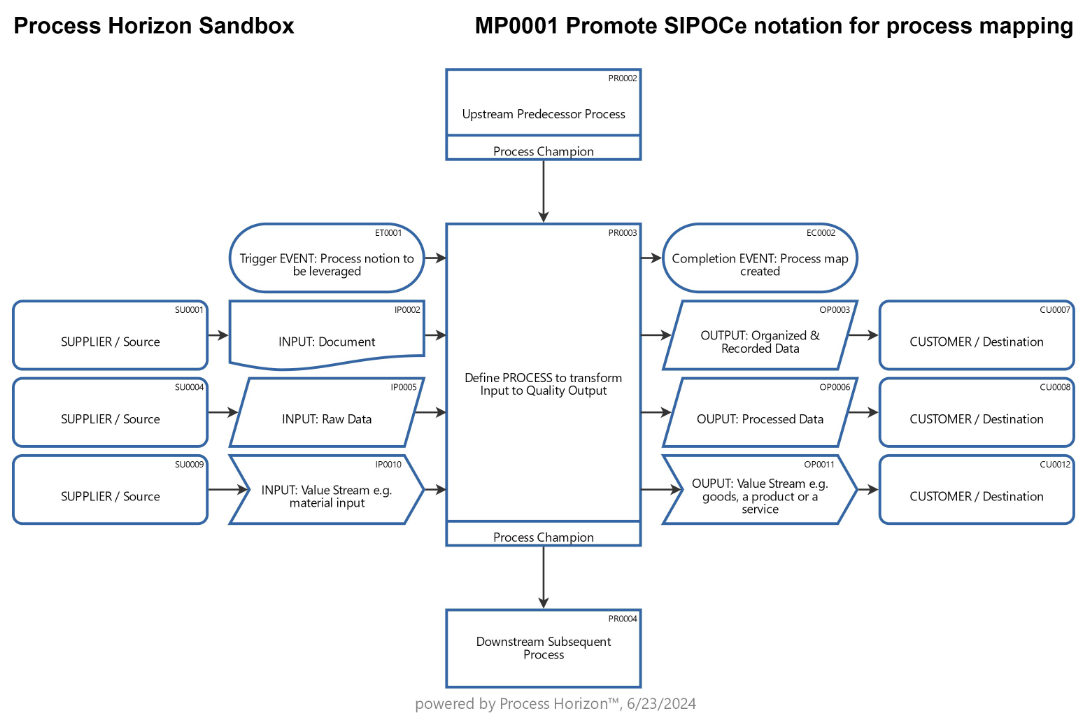Lateral SIPOC process modeling

SIPOC process modeling can be enriched by applying lateral thinking tools as follows:
- Frame the problem: decide what perspective the SIPOC is capturing
- Deconstruct complexity: break the system into manageable SIPOC slices
- Apply first principles: question each element’s necessity
- Use cause-and-effect reasoning: map dependencies & drivers
- Recognize patterns: link to other processes or contexts
- Apply second-order thinking: anticipate ripple effects of changes
- Test: iterate by validating with data, pilots or customer feedback
Here’s how we can design a smart order fulfillment SIPOC process model e.g. for an e-commerce company by layering the lateral thinking approaches:
1. Framing the Problem
- If the problem is framed as “maximize customer delight,” then “customer” = end buyer.
- If the problem is framed as “minimize working capital,” then “customer” may shift to finance department expecting accurate receivables
- If framed as “minimize risk”, regulatory bodies (tax authorities, auditors) become hidden customers
Insight: Reframing changes the SIPOC boundaries and even who counts as a customer.
2. Deconstructing Complexity
- Break “Process” into 3 subprocess SIPOCs:
- Order Capture (web => ERP => payment)
- Order Fulfillment (inventory => warehouse => logistics)
- Customer Experience (notifications => returns => feedback)
Insight: Customers don’t see these as separate, but decomposing complexity clarifies which subprocess drives which output failure.
3. First Principles Thinking
- Why do we need physical warehouses? Could drop-shipping eliminate stock inputs entirely ?
- Why do we confirm payment before shipping? In some models (e.g. cash on delivery), payment confirmation can shift downstream
Insight: Outputs don’t need to be defined as “shipped product”, the core outcome is “customer receives what they value.” That could be digital delivery, 3D printing on demand or physical shipment
4. Cause & Effect Reasoning
- Late deliveries (O) <= Shipping bottlenecks (P: ship to customer) <= Courier capacity (S: logistics provider)
- High cart abandonment (before I) <= Payment failures (I: payment confirmation) <= Outdated API with payment gateway
Insight: Many “customer issues” are really upstream input/supplier issues.
5. Pattern Recognition
- Orders with high return rates usually involve certain suppliers or certain stock keeping units => pattern suggests issues with product quality or customer expectation misalignment
- Shipping delays often cluster around the same 2 logistics providers => not random, but a pattern of systemic weakness
Insight: Group suppliers not just by function but by performance archetypes (reliable, volatile, fast but costly).
6. Second-Order Thinking
- Introducing faster shipping (O) improves customer satisfaction short-term, but second-order effect = higher carbon footprint => reputational risk with eco-conscious customers
- Automating picking (P) increases speed but reduces human inspection => second-order effect = more defective items reaching customers
Insight: Outputs need to be mapped with their unintended customer & ecosystem consequences.
7. Testing
- Run A/B tests: What if orders are shipped before payment validation? => Risk vs. increased speed ?
- Pilot with alternative couriers => Measure impact on delivery times & customer satisfaction
- Remove packaging inserts => Test whether it affects returns or satisfaction
Insight: A SIPOC should not be static, i.e. hypotheses about suppliers, inputs or outputs should be experimentally validated.
SIPOC thus becomes a creative diagnostic framework that questions assumptions, anticipates risks and generates alternative design options as proposed for the order fulfillment process.

